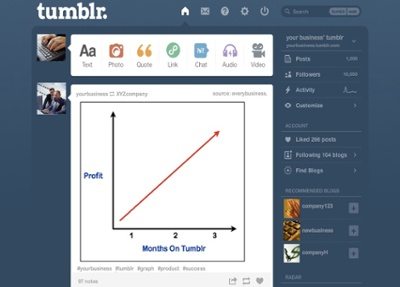 All the cool kids are on Tumblr. Well, at least 300 million of them are.
All the cool kids are on Tumblr. Well, at least 300 million of them are.
On average, more than 187 million Tumblr blogs generate over 88 million posts every day. *That’s a lot of millions.
According to a study by GlobalWebIndex, those numbers continue to grow. In fact, in the past six months active usage of Tumblr has increased by 22%. Comparatively, active usage of social media giant Facebook has dropped 6%.
A website with those statistics is prime real estate for companies that want to be seen and heard through the cacophony that is the World Wide Web.
What exactly is Tumblr?
Tumblr is a microblogging platform founded in 2007 by David Karp. In 2013, Yahoo! bought the company for $1.1 million. Today, it is one of the most popular social media websites, catching up with Facebook and Twitter in user-ship.
What makes Tumblr so popular?
Tumblr combines the best features of other popular social media sites into one easy-to-use platform. “Tumblr lets you effortlessly share anything.Post text, photos, quotes, links, music, and videos from your browser, phone, desktop, email or wherever you happen to be. You can customize everything, from colors to your theme’s HTML.”*
In a society that would rather see a picture or watch a video than read an article, Tumblr is driven by the use of images in posts. At least half of all Tumblr posts are based on images. Tumblr users exist all over the world, and images help to bridge the language barrier.
Tumblr-ers use tags to group similar posts together, and users can search for content on Tumblr using tags. Additionally, web indexing, a feature Facebook does not use, allows Internet search engines to retrieve information from Tumblr. Basically, it is free search engine optimization.
How will Tumblr benefit my company?
Companies can use Tumblr as free advertising. You can post pictures, videos, and short blurbs about your products. Linking your Tumblr posts to your company’s official website will easily increase the traffic on your website.
Are you interested in total social media domination for your company but don’t have time to log on to every site individually? No problem. Users can sync Tumblr to Twitter, Facebook and Instagram with the click of a button. This allows your Tumblr content to be cross-posted to the other social media sites, and you only have to make one post instead of four.
You’ve convinced me. How do I get started?
First, you’ll need to go to tumblr.com. Pick a username and password; try to use the same username as your Twitter or other social media username. Keep it simple and uniform.
Terms to Know:
- Dashboard: This is like the “home page” of Tumblr. You find everything you need to navigate Tumblr on this page.
- Queue: Use your queue to schedule your posts to be published at the intervals of your choice.
- Tags: Allow other users to find your posts by tagging them with relevant key words.
- Followers: These are blogs that want your posts on their dashboard. Check their blogs out, too. You might want to follow back!
- Like: Click the “heart” to save a post to your “likes.” You can reference these at any time from your dashboard.
- Reblog: It is the button to the left of the heart. This will publish the post to your blog while maintaining the original source.
Next, customize your blog. Tumblr offers plenty of ready-to-use free and paid themes, most of which are customizable. If you are HTML savvy, you can create your own theme code for your blog. The personalization possibilities are endless.
It is time to step out into the Tumblr-verse. Search for blogs that are similar or relevant to the interests of your company and follow them. You will be able to “like” and “reblog” their posts from your dashboard.
Finally, be sure to keep your blog active and up-to-date. A contemporary online presence will help your company grow. Take advantage of Tumblr’s current popularity and status as a top social media platform.
Sources and Links:
https://www.tumblr.com/press
- http://www.mediabistro.com/alltwitter/social-media-usage-q2-2014_b57126
- http://en.wikipedia.org/wiki/Microblogging
- https://www.tumblr.com/about
- http://en.wikipedia.org/wiki/Web_indexing
- https://www.tumblr.com/register
- http://en.wikipedia.org/wiki/HTML
